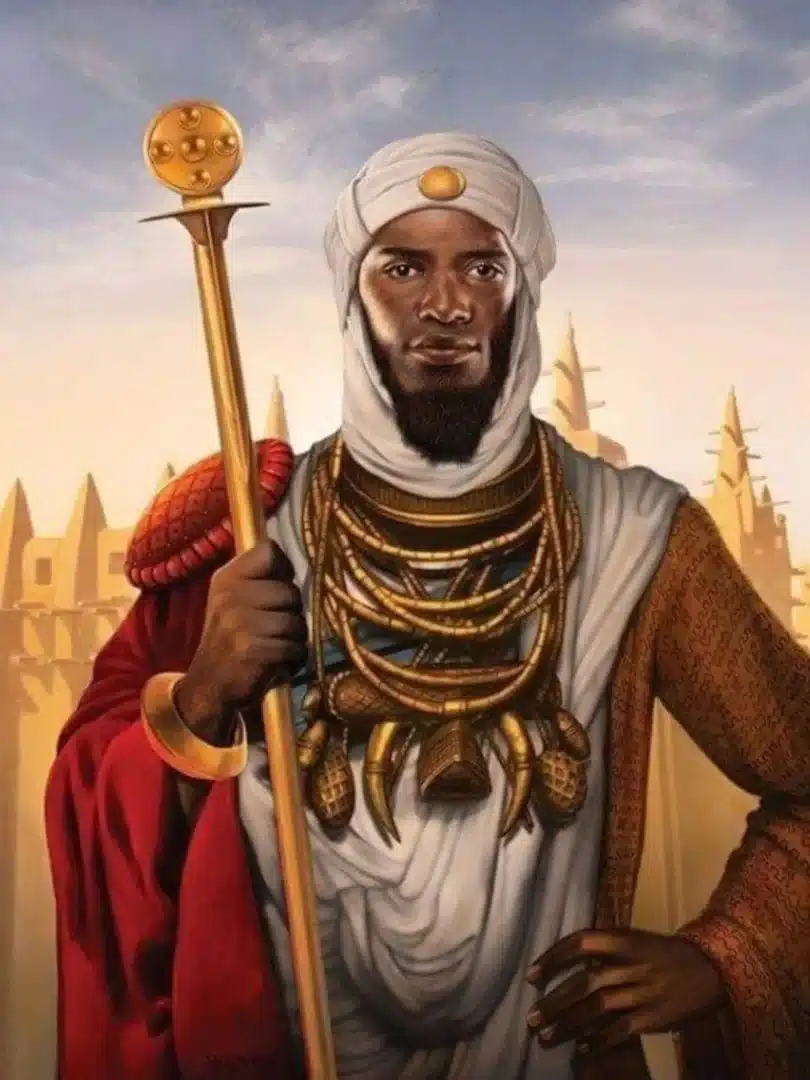Mansa Musa, the tenth Mansa or ‘Emperor’ of the wealthy Malian Empire, is often regarded as one of the richest individuals in history. His wealth, adjusted for inflation, is estimated to be around $400 billion, making him wealthier than contemporary billionaires like Musk and Bezos.
Table of Contents
Who was Mansa Musa?
Mansa Musa, born in 1280 AD, ruled the vast kingdom of Mali in West Africa. Ascending to the throne in 1312 AD, he is renowned for his extraordinary wealth, devout Islamic faith, and his grand pilgrimage to Mecca.
Mansa Musa’s Country: The Malian Empire
Musa reigned over the Malian Empire, which during his rule, reached its territorial peak. The empire covered a significant part of West Africa, showcasing a rich and diverse culture.
Mansa Musa Net Worth
He is estimated to be around $400 billion
Name and Titles
Mansa Musa’s name translates to ‘Musa, son of Abi Bakr’. ‘Mansa’ is a title meaning ‘ruler’ or ‘king’. He was also known as Kanku Musa and Hidji Mansa Musa, the latter in reference to his hajj.
Lineage and Accession to the Throne
Musa was the son of Faga Leye and possibly a woman named Kanku. He ascended the throne under unclear circumstances, possibly after his predecessor’s failure to return from an exploratory expedition.
Wealth and Generosity
Mansa Musa’s wealth primarily came from the abundant gold resources of the Mali Empire. His generosity was legendary, particularly during his pilgrimage to Mecca, where he distributed vast amounts of gold.
- RELATED: Who is Gene Rayburn? All About Life and Death of Match Game host
- RELATED: Who was Barbara Graham? All About Her Tragic Life and Public Death
- RELATED: Who was Brian Peppers? Death tragic life and addiction struggles
- RELATED: Who was Girija Tickoo? Cause Of Death And Everything You Need To Know
Early Reign and Military Conflicts
During his early reign, Musa engaged in military conflicts to consolidate and expand his empire. His rule marked a period of significant expansion for the Mali Empire.
Economy and Education
Under Mansa Musa, the Mali Empire flourished economically and culturally. Cities like Timbuktu and Gao became centers of trade and Islamic scholarship. He was instrumental in establishing the University of Sankore.
Pilgrimage to Mecca
Mansa Musa’s pilgrimage to Mecca in 1324 is one of the most well-documented events of his reign. His caravan included thousands of men and slaves, heralds in silk, and camels carrying gold.
Construction in Mali
Mansa Musa embarked on a large building program, constructing mosques and madrasas. The most notable among these is the Sankore Madrasah in Timbuktu.
Length of Rule and Death
Mansa Musa ruled from 1312 C.E. to around 1337 C.E. The exact year of his death is debated, with some sources suggesting it was in 1332 and others in 1337.
Misplaced Generosity and Economic Impact
Musa’s generosity during his pilgrimage inadvertently destabilized the regional economy, particularly in Cairo, Medina, and Mecca. The influx of gold devalued the metal, causing economic inflation.
Legacy
Mansa Musa’s reign is often considered Mali’s golden age. However, some oral traditions criticize him for being unfaithful to tradition and wasting Mali’s wealth.
Historical Sources
Information about Mansa Musa comes from Arabic sources like Al-Umari and Ibn Khaldun, 17th-century manuscripts from Timbuktu, and oral traditions.
Conclusion
Mansa Musa’s life story is one of unparalleled wealth, devout faith, and profound impact on the Mali Empire and beyond. His legacy continues to fascinate and inspire, highlighting a significant era in African history.
FAQs about Mansa Musa
- What was Mansa Musa’s net worth?
- Approximately $400 billion, adjusted for inflation.
- What empire did he rule?
- The Malian Empire in West Africa.
- What is Mansa Musa known for?
- His immense wealth, generous pilgrimage to Mecca, and significant contributions to the Mali Empire’s culture and education.
- How did he impact the economy?
- His generous distribution of gold during his pilgrimage caused temporary economic inflation in several regions.
- What was his most significant contribution to architecture?
- The construction of the Sankore Madrasah in Timbuktu.













